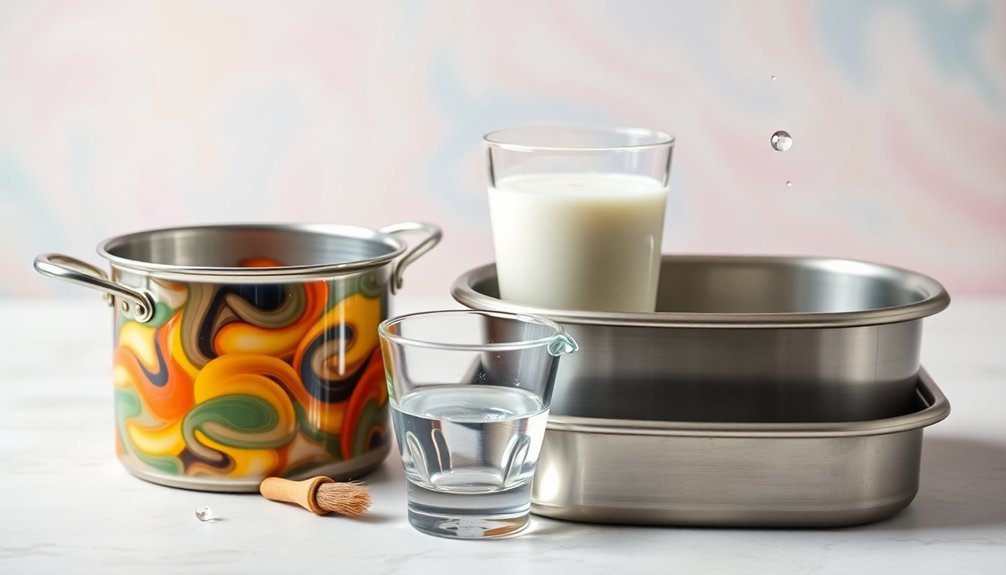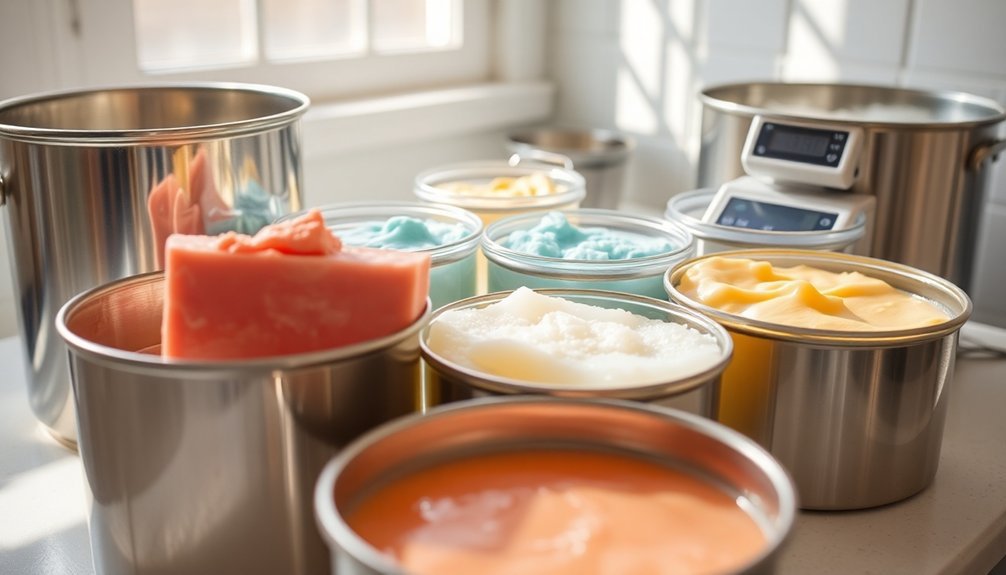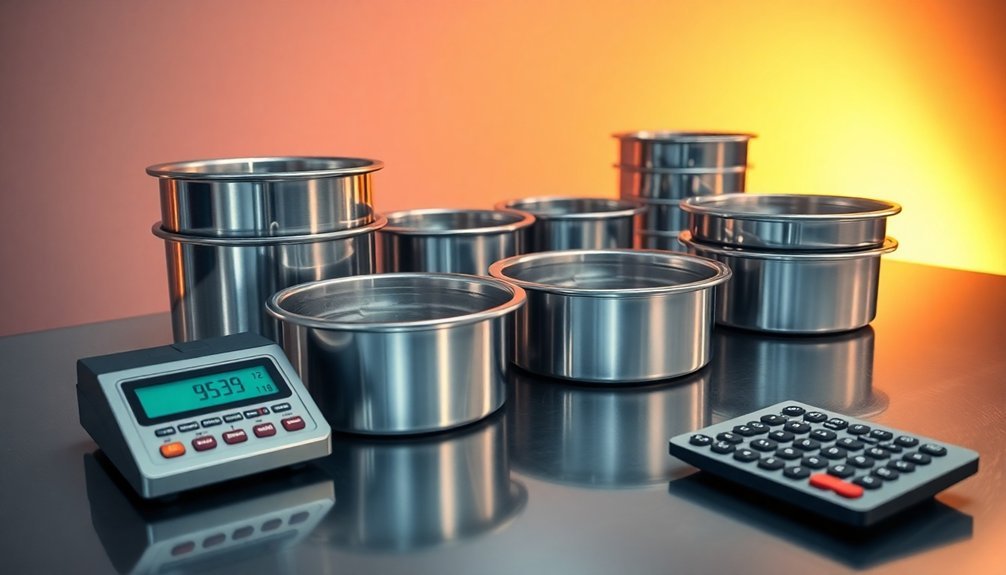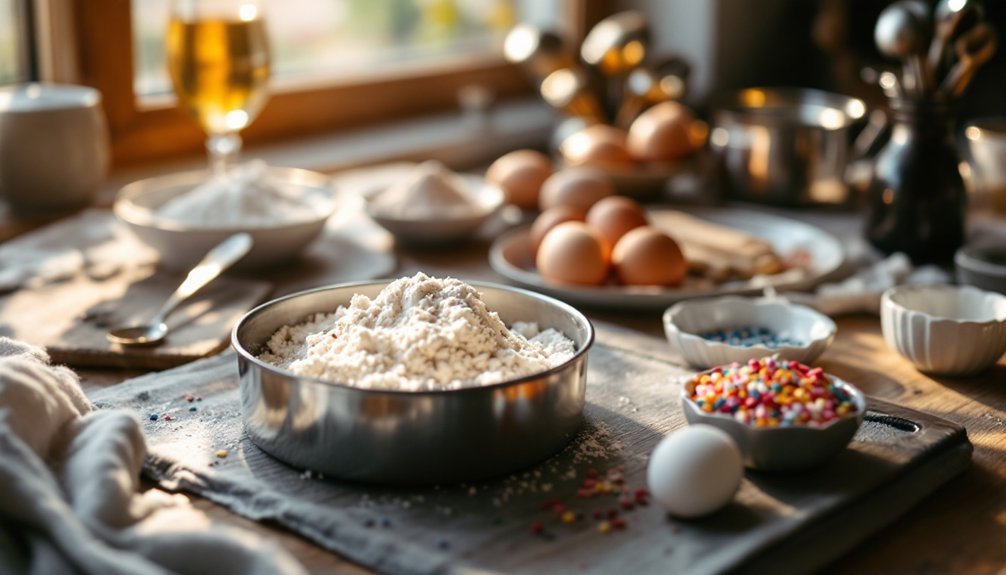Calculating your batch pan size first prevents overflow disasters that can waste ingredients and create cleanup nightmares. You'll need to account for 25-30% expansion during saponification, especially with cold process soaps. Proper sizing guarantees ideal conditions for your soap to cure correctly, affects final bar quality, and improves your production efficiency. Different oil types and additives alter volumes markedly, requiring precise measurements. The right container choice also depends on understanding these expansion factors.
Understanding Vessel Capacity Requirements for Your Soap Recipe

When selecting a container for soap making, why do so many beginners face overflow issues? It often comes down to underestimating the volume requirements and failing to account for expansion during saponification.
You'll need to weigh all ingredients precisely on a digital scale and calculate their total volume plus expansion space.
Choose containers made of heavy-duty plastic or stainless steel as they won't react with lye. Glass can shatter and aluminum will react negatively. For convenience and chemical resistance, many experienced soap makers use heavy-duty Tupperware or similar containers as recommended in essential soapmaking equipment lists.
Your vessel should accommodate not just the initial recipe volume but include a 25-30% safety margin to prevent messy overflows during blending.
Remember that cold process soaps typically require more space than hot process versions, and different oil combinations can affect density and final volume substantially.
The Science Behind Optimal Soap Batch Volumes
Understanding the science behind soap batch volumes requires more than just measuring ingredients haphazardly. The density of your soap directly impacts how much product will fill your mold, with various factors influencing this vital property.
| Factor | Impact | Adjustment Needed |
|---|---|---|
| Oil Types | Different densities | Adjust recipe weights |
| Superfat % | Changes consistency | Recalculate lye amount |
| Additives | Alters volume/weight | Adjust total batch size |
You'll find that saponification itself transforms your ingredients' physical properties. When you're working with irregular molds, use water displacement to determine capacity accurately. For rectangular molds, multiply length × width × height, but remember that the resulting volume must align with your recipe's weight considering soap density. Maintaining detailed batch records helps you achieve consistency across future batches.
Preventing Overflow Disasters: Why Size Matters in Saponification

The disaster of soap overflowing your molds can ruin not only your carefully crafted batch but also damage your equipment and workspace. Precise measurement is your best defense against this common soapmaking mishap.
To calculate your required volume, multiply your mold's length, width, and depth to determine capacity in milliliters or ounces. For irregular molds, fill with water and weigh to estimate volume—soap is slightly denser than water, so adjust accordingly. Understanding the relationship between oil weight vs. yield helps prevent miscalculating your batch size for specific molds.
Proper sizing isn't just about preventing messes; it guarantees ideal saponification conditions that affect your soap's texture and hardness.
You'll also maintain consistency in your designs, especially vital for layered or decorative soaps. The right calculations minimize waste, reduce safety hazards from caustic spills, and streamline your production process.
Economic Benefits of Proper Vessel Sizing in Traditional Soap Production
Proper vessel sizing in your soap production directly reduces costs by enhancing material handling through fewer transfers and less waste.
You'll notice immediate savings in energy consumption when using appropriately sized batch pans that heat more efficiently and maintain ideal temperatures.
These economic benefits translate to improved profit margins while maintaining product quality, making vessel sizing an essential factor in traditional soap manufacturing economics.
Cost-Saving Material Handling
Effective batch pan sizing stands at the core of cost-efficient soap production operations. When you calculate your pan dimensions properly, you'll streamline your workflow and dramatically reduce material waste. This precision minimizes costly spills and overproduction while optimizing your labor allocation.
| Consequence | Improper Sizing | Proper Sizing |
|---|---|---|
| Material Waste | Ingredients lost to overflow | Every drop utilized |
| Labor Hours | Extended cleanup time | Quick processing |
| Equipment Wear | Accelerated deterioration | Extended lifespan |
| Workplace Safety | Increased spill hazards | Reduced accident risk |
| Production Flow | Frequent interruptions | Smooth operations |
With precise batch calculations, you'll create a safer workspace while reducing cleanup time. Your equipment will last longer, and you'll experience fewer workflow disruptions—all contributing to significant cost savings that directly impact your bottom line.
Reduced Energy Consumption
When sizing your batch pans correctly, you'll markedly reduce energy consumption across your soap production operation. Properly sized vessels maintain stable temperatures by minimizing heat loss, directly lowering your energy bills.
You'll benefit from optimized heating times during critical processes like melting oils and fats. Since your equipment won't need to work as hard to heat oversized containers, your production becomes more energy-efficient.
This efficiency creates a simplified production environment where temperature control is more predictable and manageable.
The environmental impact shouldn't be overlooked—your energy savings translate to a reduced carbon footprint. By calculating your batch pan size first, you're not just making a technical decision; you're implementing a sustainable practice that benefits both your bottom line and the planet.
How Material Density Affects Your Soap Making Container Choice

Understanding the density of your soap materials directly impacts which containers will work best for your soap making process. Lye solutions are heavier than water, requiring containers that can safely support this additional weight without failing. Thin-walled containers can easily crack or deform when exposed to the weight and heat of lye solutions.
Your soap's formula will determine its overall density, which affects both the size and material of container you'll need. Remember that temperature fluctuations during the mixing process create additional stress on your containers. Always select materials with built-in safety margins for unexpected volume increases.
Materials like polypropylene (PP) offer excellent alkali resistance and can withstand the heat of soap making, while HDPE provides chemical resistance but may not handle extreme temperatures.
Avoid aluminum and PET plastic entirely as they'll degrade when exposed to lye, potentially compromising both your soap quality and safety.
Scaling Your Soap Production: From Kitchen to Commercial Batches
Shifting from small kitchen batches to commercial-scale soap production requires careful planning and strategic equipment upgrades.
You'll need to convert from individual molds to more efficient slab molds that guarantee consistency across larger batches.
Consider masterbatching your ingredients to streamline production and maintain quality control as you scale. This approach helps manage recipe adjustments when increasing batch sizes, particularly with water discounts that might affect texture and curing times.
Equipment investments become essential—stick blenders, large pots, and potentially commercial mixers will replace your home tools. Calculating the correct batch pan size before ordering equipment saves considerable time and resources when scaling up production.
For hot process methods, crockpots and turkey roasters offer intermediate solutions before investing in industrial equipment.
Remember that consistent quality remains paramount. Implementing a production calendar will help you manage increased orders while maintaining the craftsmanship that built your brand.
Calculating Expansion Factors for Cold and Hot Process Methods

As your production scales up, you'll face a key technical challenge: accurately accounting for how soap expands during the manufacturing process.
Cold process soap typically expands differently than hot process varieties, with cold process requiring more airflow consideration during curing, while hot process soap deals with higher temperature-driven expansion. The difference is primarily due to saponification reactions that continue throughout the curing process in cold process soaps.
- Prevent Costly Overflows – Nothing's more frustrating than watching your carefully crafted soap spill over mold edges, wasting ingredients and creating messy cleanup.
- Ensure Batch Consistency – Your customers expect the same size and quality with each purchase; inconsistent expansion leads to irregular bars.
- Maximize Production Efficiency – With precise expansion calculations, you'll optimize your equipment investment and storage space, saving thousands in unnecessary capital expenses.
Traditional Vessel Types and Their Capacity Considerations
Three primary vessel types dominate soap production: stainless steel, glass, and polyethylene containers. Each offers distinct advantages depending on your batch size and soap-making method.
Stainless steel vessels provide excellent corrosion resistance and withstand high temperatures, making them ideal for hot process methods.
Glass containers offer transparency, allowing you to monitor your soap's development during saponification.
Lightweight polyethylene works well for cold process soaps and non-reactive formulations.
When selecting your vessel, consider volume flexibility to accommodate different batch sizes. The container's geometric design affects mixing efficiency, while material choice impacts durability and chemical compatibility.
Remember that larger vessels face scalability limitations due to material strength constraints. Your operational mode—whether batch, fed-batch, or semi-batch—should also influence your vessel selection for best results.
Frequently Asked Questions
How Does Altitude Affect Batch Pan Size Calculations?
At higher altitudes, you'll need to adjust batch pan size calculations to account for lower boiling points, increased evaporation rates, and altered heating efficiency, ensuring your processing times and product quality remain consistent.
Can I Use the Same Pan for Different Soap Formulations?
Yes, you can use the same pan for different soap formulations. You'll just need to adjust your ingredient ratios accordingly using a lye calculator to guarantee proper saponification for each unique recipe you create.
What Safety Margin Should I Add to Calculated Batch Volumes?
Add a 10-15% safety margin to your calculated batch volumes. This buffer will prevent overflow during production and account for unexpected variations in your soap formulations while ensuring you'll still have enough product.
How Do Seasonal Temperature Variations Impact Optimal Pan Sizing?
Seasonal temperature variations affect your ideal pan sizing by changing evaporation rates and boiling efficiency. You'll need larger pans in colder seasons as heat transfer decreases, while summer conditions may allow smaller, more efficient designs.
When Should I Replace My Batch Pan Due to Efficiency Concerns?
You should replace your batch pan when you notice consistently declining efficiency, increased maintenance costs, quality issues, or if it's preventing production scaling. Don't wait until complete failure compromises your operations.
In Summary
By calculating your batch pan size first, you'll save yourself from messy overflows, wasted ingredients, and ruined batches. You're ensuring your vessel can comfortably accommodate the entire soap mixture plus expansion during saponification. Whether you're crafting small kitchen batches or scaling to commercial production, proper sizing isn't just practical—it's economical. Don't skip this vital first step if you want consistent, professional results every time.





Leave a Reply